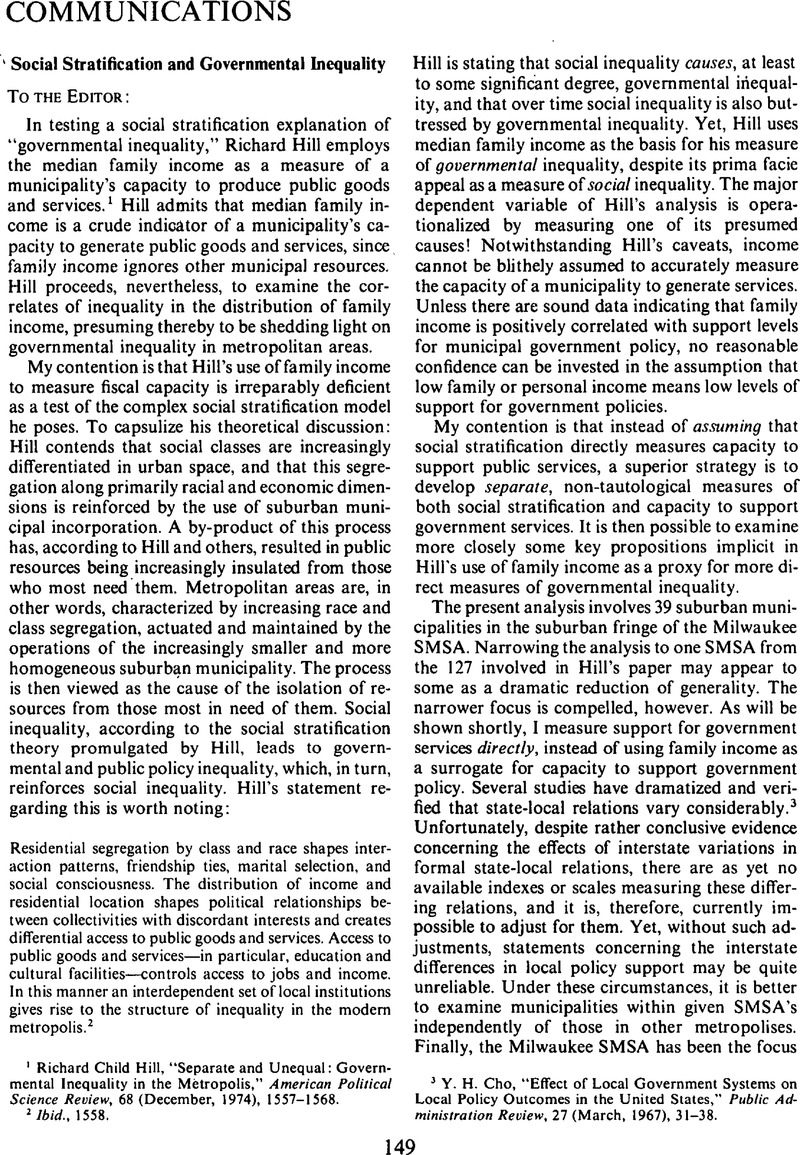Published online by Cambridge University Press: 01 August 2014

1 Hill, Richard Child, “Separate and Unequal: Governmental Inequality in the Metropolis,” American Political Science Review, 68 (12, 1974), 1557–1568 CrossRefGoogle Scholar.
2 Ibid., 1558.
3 Cho, Y. H., “Effect of Local Government Systems on Local Policy Outcomes in the United States,” Public Administration Review, 27 (03, 1967), 31–38 CrossRefGoogle Scholar.
4 Boelaert, Remi, “Political Fragmentation and Inequality of Fiscal Capacity in the Milwaukee SMSA,” National Tax Journal, 23 (03, 1970), 83–88 CrossRefGoogle Scholar; Curran, Donald J., Metropolitan Financing: The Milwaukee Experience, 1920–70 (Madison, Wisconsin: University of Wisconsin Press, 1973)Google Scholar.
5 The municipalities are: In Milwaukee County: Bay-side, Brown Deer, Cudahay, Fox Point, Franklin, Glen-dale, Greenfield, Oak Creek, St. Francis, Wauwatosa, West Allis, Greendale, Hales Corners, River Hills, Shore-wood, West Milwaukee, and Whitefish Bay. In Ozaukee County: Cedarburgh, Mequon, Port Washington, Grafton, and Thiensville. In Washington County: Hartford, West Bend, and Kewaskum. In Waukesha County: Elm Grove, Hartland, Menominee Falls, Mukwonago, and Pewaukee.
6 These data were collected from U.S. Census Bureau information provided to the Southeastern Wisconsin Regional Planning Commission and aggregated by the latter organization to the municipal level.
7 The validity of this measure being interpreted as a measure of low status is heightened because it is positively correlated with lower categories of income and is negatively related to higher measures of income.
8 This measure of upper status is negatively and significantly related to other measures of lower status, such as the percentage of community residents in various blue-collar and other working class occupations. Write author for supporting data.
9 Curran, , Metropolitan Financing. …, p. 52 Google Scholar.
10 A direct measure of the amount of land used for industrial and manufacturing use was not available at the data-gathering stage. Subsequently, it was determined that there is a very high correlation between the amount of land zoned industrial and the amount of land actually used for this purpose. Obviously, some amount of land zoned for this purpose is not used at all, while other land is zoned for some other purpose, but is actually used for industry or manufacturing.
11 The term market or “real” value is a term used to distinguish the equalized assessment by the state of local property for state purposes, and is not meant to suggest that this value of housing is the selling price of homes. This data, as well as the data for land zoned for industrial and manufacturing purposes, was also obtained from the Southeastern Wisconsin Regional Planning Commission.
12 Hill, , “Separate and Unequal,” p. 1562 Google Scholar.
13 A variation of multiple regression, stepwise regression provides a means of choosing independent variables which will provide the best prediction possible with the fewest independent variables. This regression routine chooses the single variable that best predicts the value of the dependent variable, and then proceeds to select other variables in order of their ability to predict the dependent variable best, in conjunction with variables already included in the model. In this instance, variables are no longer included, once they no longer add five per cent explained variance to the equation. See Nie, Norma H., Bent, Dale H., and Hull, C. Hadlai, SPSS: Statistical Package for the Social Sciences (New York: McGraw-Hill Book Company, 1970), pp. 180–181 Google Scholar.
14 The following items were gathered from sources published by the Wisconsin Department of Revenue, Municipal Audit Division.
15 Netzer, Dick, The Economics of the Properly Tax (Washington, D.C.: The Brookings Institution, 1966)Google Scholar; Wood, Robert C., 1400 Governments (Cambridge, Mass.: Harvard University Press, 1961)CrossRefGoogle Scholar.
16 Netzer, The Economics of the Property Tax.
17 “Serrano's Potential Victims,” California Journal, 5 (05, 1974), 169–170 Google Scholar.
Comments
No Comments have been published for this article.